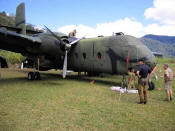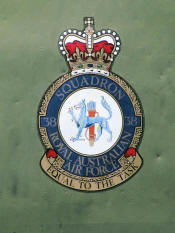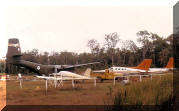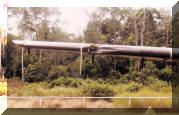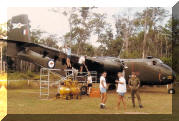 Royal
Australian Air Force
Royal
Australian Air Force 
Newest data shown in red February 8, 2022
RAAF Caribou Overseas
Click to enlarge the photos
| During 1965, Caribous from the 38 Squadron were regularly, if temporarily, based in in Papua New Guinea (PNG) then an Australian Territory since the end of World War I. Mainly for flying duties and working with the Australian Army. On October 18, 1965 the 38 Squadron had two Caribous assigned to Detachment "A" at Port Moresby, PNG. Detachment "A" stayed in PNG until late 1975 when PNG gained independence as a new nation. In the 10 years Detachment "A" flew 26,500 hours. During this time frame 3 Caribous were written off. |
 |
The attached map shows Papua New Guinea and the locations of the 3 Caribous that crashed there over the ten years between 1965 and 1975. |
 |
<<< A4-199 (cn# 199) in flight over PNG.
(Gareth Kimberley) |
|
|
<<<An RAAF Caribou landing at Guari. (Ian Sutherland) >>> RAAF Caribou operating out of Mende, Papua New Guinea during famine relief operations, Oct. 1972 (Denis Hersey -Australian - DPAO) |
Papua New Guinea (1976 - 2009)
|
At about 1415 on the 23rd October, 1978, Caribou A4-164 crashed on take-off from remote Eliptamin airfield, PNG, 15 kilometres northeast of Telefomin in the Wewak FIA.
All three crew, captain Flight Lieutenant Bob Burstall, co-pilot Pilot Officer Mark Freeman and loady Corporal John Young, were unhurt. According to later 1978 press reporting, the ensuing salvage operation commenced on the 27th October 1978 when nine RAAF aircraft ferried 35 experts to the site in Papua New Guinea's West Sepik Province.
Hindered by the high altitude (5,600ft) and the lack of support equipment, the salvage crew stripped the Caribou. Trees were felled to make an improvised gantry for removing the wing. The engines, each weighing over 2,000lb, were hauled across the airstrip by 50 villagers and then airlifted out. Once the aircraft weight had been reduced to around 11,000lb, an RAAF Chinook, its lifting ability reduced by the high altitude, was able to move the fuselage.
The Caribou was taken the 145 miles to the coast after a five-hour journey and two refuelling stops with a second Chinook carrying the fuel. A4-164 was subsequently repaired and returned to service. On the 30th May 1991 the Minister for Defence announced the Caribou fleet would be reduced from 21 to 14 aircraft, and A4-164 was the first withdrawn from service in November, 1992.
It became a training aid at Richmond. The wings and tail section were removed and are now fitted to A4-173 at the Queensland Air Museum at Caloundra. (Thanks to Radschool Association Vol 76 January, 2022) |
 |
United Nations Service (1975 - 1978)
In February,
1975 Australia announced it would provide a Caribou aircraft to
support of the United Nations Military Observer Group in India and
Pakistan (UNMOGIP). Aircraft from the 38 Squadron would get the duty
an operate as Detachment "B". The single Caribou detachment base
would alternated between Rawlpindi, Pakistan between May and
October) and Srinigar, India for the other six months of the year.
On March 4, 1975 A4-199 departed Richmond for India painted white
with blue United Nations marking. The Caribou sortie was flown On
April 1, 1975.
Three Caribous were involved in the UNMOGIP operation.
A4-199, A4-152, A4-264 . Each Caribou was assigned a four month
rotation.
Eeach Caribou serviced three tours with UNMOGIP .
A4-264 flow the last sortie on December 30, 1978. It returned to
Richmond AB in January, 1979.
 |
<<< Three
of the RAAF 38th Squadron that were painted white for United Nation
duty. ( Date and location unknown) >>> 38 Squadron Detachment "B" UNMOGIP patch |
 |
EAST TIMOR (1975)
| The story of the hijack of RAAF Caribou A4-140. Click on this to see the article from Radschool Association Magazine, Volume 58 |
 |
<<< A4-140 on the tarmac
at Dili airfield, East Timor with Red Cross markings. >>> A4-199 the replacement for A4-140 in white paint with Red Cross markings. |
 |
| You are on RAAF Caribou Section 6 - page 1 | ||
| Return to RAAF Home Page | Return to Caribou index page | Next page |






